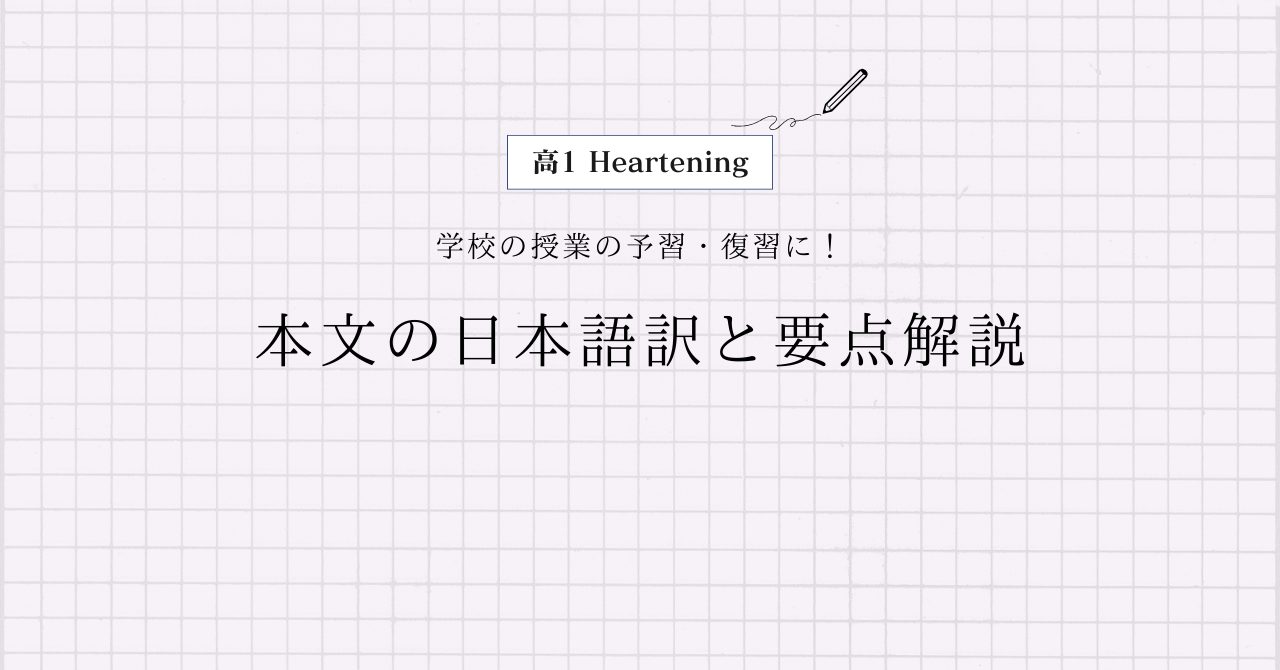桐原書店 高1Heartening Lesson6 Section1の本文の日本語訳と重要箇所の解説です。
Lesson6-2, 6-3, 6-4の解説はこちらからご覧ください。
>高1Heartening Lesson6 Section2 本文和訳
>高1Heartening Lesson6 Section3 本文和訳
>高1Heartening Lesson6 Section4 本文和訳
- Heartening Lesson6 Section1 本文と日本語訳
- Heartening Lesson6 Section1 重要事項の解説
- You are listening to a lecture by a professor about dinosaurs.
- Dinosaurs first appeared about 230 million years ago.
- For over 100 million years they ruled the earth.
- They varied greatly in size and shape.
- Some were very big, like the tyrannosaurus.
- It was thirteen meters long.
- Others were as small as a dog.
- Then, 66 million years ago, they became extinct. But why?
- The most likely cause is an asteroid that struck Mexico.
- That completely changed the earth’s environment, and so the dinosaurs couldn’t survive.
- By the way, have you ever seen Jurassic Park?
- In that movie scientists bring the dinosaurs back to life with advanced technology.
- They use mosquito fossils that are tens of millions of years old.
- Those mosquitos fed on dinosaur blood, and they remained trapped in amber.
- The scientists take out dinosaur DNA from the blood.
- Then they clone dinosaurs from it.
- But is it scientifically possible to bring dinosaurs back to life that way?
- Heartening Lesson6 Section1 まとめ
Heartening Lesson6 Section1 本文と日本語訳
You are listening to a lecture by a professor about dinosaurs.
「あなたは恐竜に関する教授による講義を聞いています。」
Now I’m going to talk about dinosaurs.
「では、恐竜について話していきます。」
Dinosaurs first appeared about 230 million years ago.
「恐竜は約2憶3000年前に初めて現れました。」
For over 100 million years they ruled the earth.
「1億年以上の間、恐竜は地球を支配しました。」
They varied greatly in size and shape.
「恐竜によって大きさと形は大きく異なります。」
Some were very big, like the tyrannosaurus.
「ティラノサウルスのようなとても大きい恐竜もいました。」
It was thirteen meters long.
「ティラノサウルスは全長13メートルでした。」
Others were as small as a dog.
「犬と同じくらい小さい恐竜もいました。」
Then, 66 million years ago, they became extinct. But why?
「それから6600万年前、恐竜は絶滅しました。しかしなぜでしょう?」
The most likely cause is an asteroid that struck Mexico.
「最も可能性がある原因はメキシコに落ちた小惑星です。」
That completely changed the earth’s environment, and so the dinosaurs couldn’t survive.
「そのことは地球の環境を完全に変え、そのため恐竜は生き残ることができませんでした。」
By the way, have you ever seen Jurassic Park?
「ところで、あなたは今までにジュラシックパークを見たことはありますか?」
In that movie scientists bring the dinosaurs back to life with advanced technology.
「その映画の中で、科学者が最新技術によって恐竜を生き返らせます。」
They use mosquito fossils that are tens of millions of years old.
「彼らは数千万年前の蚊の化石を使います。」
Those mosquitos fed on dinosaur blood, and they remained trapped in amber.
「それらの蚊は恐竜の血を食料としていて、琥珀の中に閉じ込められていました。」
The scientists take out dinosaur DNA from the blood.
「科学者たちはその血から恐竜のDNAを取り出します。」
Then they clone dinosaurs from it.
「その後、DNAから恐竜のクローンを作ります。」
But is it scientifically possible to bring dinosaurs back to life that way?
「しかし、そのような方法で恐竜を生き返らせるのは科学的に可能なのでしょうか?」

Heartening Lesson6 Section1 重要事項の解説
You are listening to a lecture by a professor about dinosaurs.
ここでは「現在進行形」が使われていますね。
“lecture“は「講義、講演」、“professor”は「教授」は、“dinosaur”は「恐竜」という名詞になります。
Dinosaurs first appeared about 230 million years ago.
“first”は「初めて」という副詞で、“appear”は「現れる」という動詞です。
“million”は「100万(の)」という意味ですね。
For over 100 million years they ruled the earth.
“for 数字”は「~間」という重要表現です。
“over”は「~より多くの」という意味です。“more than~”も同じ意味があります。
ただし,人口や年月など元の数が大きい場合,つまりその数を含んでいるかが問題でない場合は「~以上」と訳してもOKです。
“they”は“Dinosaurs”を指していて、“rule”は「を支配する」という動詞、“earth”は「地球」という名詞です。
They varied greatly in size and shape.
“They”は“Dinosaurs”を指していて、“vary”は「を変える」という動詞です。
“vary in~”は「~という点で異なる、主語によって~は異なる」という意味になります。
“greatly”は「大いに、非常に」といった副詞ですね。
Some were very big, like the tyrannosaurus.
“some”と“others”はセットで主語として使うことで,「~な人もいれば,…な人もいる」といった意味になります。
“like”は「~のような」という前置詞で、“tyrannosaurus”は「ティラノサウルス」です。
It was thirteen meters long.
“It”は“tyrannosaurus”を指していて、“meters long”はここでは「全長」です。
Others were as small as a dog.
ここは先ほどの“Some~”とのセットですね。
また、「同級比較」も使われています。
Then, 66 million years ago, they became extinct. But why?
“then”は「それから、その後」といった副詞です。
“they”は“Dinosaurs”を指していて、“became”は“become(になる)”の過去形です。
“extinct”は「絶滅した」という形容詞になります。
The most likely cause is an asteroid that struck Mexico.
“most likely”は「最もありえそうな、最も可能性がありそうな」という意味です。
“cause”は「原因」、“asteroid”は「小惑星」、“Mexico”は「メキシコ」という名詞ですね。
“struck”は“strike(を襲う、をぶつける)”の過去形で、“that”は「主格の関係代名詞」になります。
“that struck Mexico”が先行詞“an asteroid”を修飾しています。
That completely changed the earth’s environment, and so the dinosaurs couldn’t survive.
“That”は直前の文全体を指しています。
“completely”は「完全に、まったく」といった副詞、“change”は「を変える」という動詞です。
“environment”は「環境」という名詞になります。
名詞に‘sを付けると「~の」という所有を表します。
直前の名詞が複数形のときは” teachers‘ “のようにアポストロフィーだけを最後に付けます。
“so”は「だから、そのため」といった接続詞、“survive”は「生き残る」という動詞ですね。
By the way, have you ever seen Jurassic Park?
“by the way”は「ところで」という重要表現になります。
ここでは「現在完了の経験用法」が使われていますね。“ever”は「今までに」という副詞です。
In that movie scientists bring the dinosaurs back to life with advanced technology.
“scientist”は「科学者」という名詞です。
“bring A back to B”で「AをBに戻す」という意味で、“bring ~ back to life”で「~を生き返らせる」となります。
この“with”は「~によって」という「手段・方法」を表す前置詞で、“advanced”は「進んだ、発展した」という形容詞、“technology”は「科学技術」という名詞ですね。
They use mosquito fossils that are tens of millions of years old.
“They”は“scientists”を指しています。
“mosquito”は「蚊」、“fossil”は「化石」という名詞になります。
“that”は「主格の関係代名詞」で、“that are tens of millions of years old”が先行詞“mosquito fossils”を修飾していますね。
“tens of millions of~”は「数千万の~」という意味で、“tens of millions of years old”で「数千万年前の」となります。
Those mosquitos fed on dinosaur blood, and they remained trapped in amber.
“those”は“that”の複数形で,「あれらは(の)」といった意味になりますが,「それらは(の)」と訳すことが多いです。
“fed”は“feed(にエサを与える)”の過去形で、“feed on~”は「~をエサとする」という意味になります。
“blood”は「血」という名詞ですね。
“they”は“scientists”を指しています。
“remain”は「~のままである、残っている」という動詞で、“trapped”は「閉じ込められた」という形容詞、“amber”は「琥珀」という名詞です。
The scientists take out dinosaur DNA from the blood.
“take out~”は「~を取り出す、を持ち帰る」といった意味です。
Then they clone dinosaurs from it.
“they”は“scientists”を指していて、“clone”は「~のクローンをつくる」という動詞です。
“it”は“dinosaur DNA”を指していますね。
But is it scientifically possible to bring dinosaurs back to life that way?
この文は「it to構文」になっています。真の主語は“to bring~”ですね。
“scientifically”は「科学的に」という副詞で、“possible”は「可能性がある」といった形容詞です。
“that way”は「そのような方法で」といった表現になります。
Heartening Lesson6 Section1 まとめ
以上がHeartening Lesson6 Section1の日本語訳となります。
>高1Heartening Lesson6 Section2 本文和訳
>高1Heartening Lesson6 Section3 本文和訳
>高1Heartening Lesson6 Section4 本文和訳
何か分からない点や他に解説してほしい点があれば,お気軽にコメントしてください!


コメント